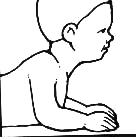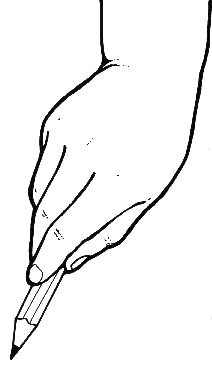DVDs, Books, and other Materials about Child Development and Children with Disabilities |
Home Page Curriculum Vitae Products by Topics FAQs Free Downloads Resource Links Order Info Contact Us |
FREQUENTLY ASKED QUESTIONS (FAQs) ABOUT HAND DEVELOPMENT
Q. Why do some children avoid watching
their hands or look at them only briefly?
A. Task analysis is
necessary to discover the cause of poor visual monitoring of hands,
since there are so many possible reasons. A child with a strong ATNR
will be able to watch only the hand on the face side of the extended
arm. If that hand attempts to bring an object to the mouth (finger food
or a spoon), the elbow flexion will result in the head turning away.
Treatment should aim to improve general midline orientation, symmetry,
and bilaterality, which in turn will help integrate the obligatory
reflexive pattern. In other cases, many children with multiple
disabilities have poor grading of neck muscles for head control. They
must maintain the head totally erect or it will flop into flexion. Thus,
fixation on their hands or objects is usually fleeting. Long-term goals
can include improving head control, but short-term intervention must
provide environmental adaptations such as head support and appropriate
positioning of objects so eyes can watch hands.
Q. Do children
need to follow every step in normal development? A. Actually, the
developmental frame of reference is useful as a guide, not as a rigid
course to follow. Many early components of hand development are
certainly foundational skills essential for the natural unfolding of the
maturation process. For example, weight-bearing in the prone position is
crucial to establish integrity of the shoulder joint in preparation for
accurate reaching, which places the hand in optimal position for grasp
or manipulation.
A. Actually, the
developmental frame of reference is useful as a guide, not as a rigid
course to follow. Many early components of hand development are
certainly foundational skills essential for the natural unfolding of the
maturation process. For example, weight-bearing in the prone position is
crucial to establish integrity of the shoulder joint in preparation for
accurate reaching, which places the hand in optimal position for grasp
or manipulation. On the other hand (no pun intended), a normal component such
as the digital-pronate grasp may deteriorate into an atypical pattern in
a child with distal spasticity whose wrist tends toward flexion and
ulnar deviation. We would encourage different grasps that would not feed
into the increased tone.
On the other hand (no pun intended), a normal component such
as the digital-pronate grasp may deteriorate into an atypical pattern in
a child with distal spasticity whose wrist tends toward flexion and
ulnar deviation. We would encourage different grasps that would not feed
into the increased tone.
Q. What can we do about
self-stimulating repetitive hand movements?
A. Normal infants
go through stages of repetitive, reflexive movements such as scratching,
clutching, tapping, etc. These patterns are gradually replaced by
explorative, accommodative and discriminative movements linked to
cognitive awareness and labeling of objects through language. The more
mobile the developing child, the more opportunity that child has to seek
and receive necessary tactile input. People with cognitive and/or
mobility impairments still have strong needs for sensory input and motor
output, but since the developmental process is interrupted, they get
stuck using primitive patterns to satisfy those needs. Our intervention
depends on the specific developmental levels and sensory motor needs of
the individual. For example, a child with very low muscle tone and hands
that have never accommodated (shaped) to a variety of objects may need
manual assistance in exploring the sensory attributes, concurrently with
learning the name and use of functional objects. An older child with
cognitive delays and problematic self-stim behaviors may need a sensory
diet that addresses ways of providing proprioceptive and vestibular
input as well as tactile, through selected activities that are
age-appropriate and functional, such as scrubbing, vacuuming, hammering,
pushing a wheelbarrow, carrying groceries.
Adapted from: Erhardt, R.P. (June 9, 1997). Hand Function Series #1. Hand development: Answers to some common questions. ADVANCE for Occupational Therapists, 13(23) 12.
You are welcome to copy and paste this page for your own clinical or educational use.